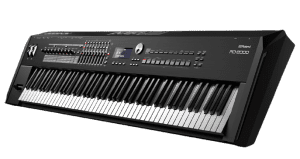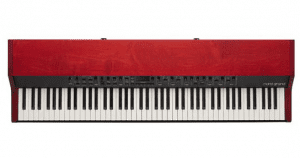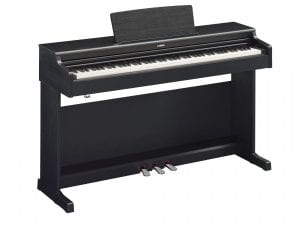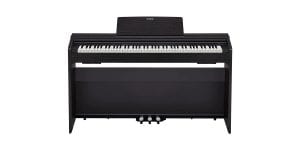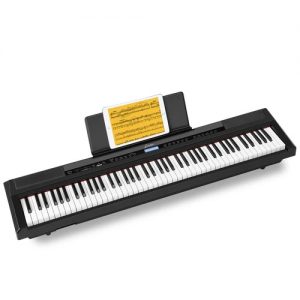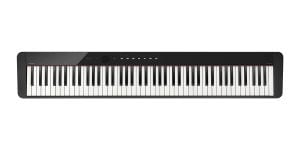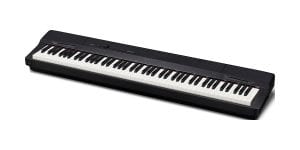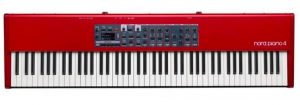Pianists looking for the best sounding digital pianos either look for the best-sounding units or look for pianos that connect with an external amplification system. The speakers in the digital piano transform the electrical energy coming from the source into mechanical energy. The sound of the piano is completely dependent on the quality of its speakers. The internal and inbuilt speakers in the pianos come in different sizes and price ranges and guarantee the best playing experience for the musician.
The sounding system in the digital piano is one of the first and the most important feature to look for in a digital piano, as it decides the quality of the performance in a stage show or a live event. We have listed the top 10 best sounding digital pianos here from some of the leading brands to help you in your search.
Most Realistic and Best Sounding Digital Pianos
Top 10 Best Sounding Digital Pianos of 2024
#1. Roland RD-2000 Stage Piano – Best Overall
The best among the best sounding digital pianos is Roland RD-2000 Stage Piano. The pianist who performs frequent stage shows prefers to use the Roland RD-2000 stage piano, as this piano is a real powerhouse of some serious music with tremendous audio reachability.
This is an ambient stage-friendly piano that renders unmatched performance with extensive control of the keys. The RD-2000 features two independent sound engines, an exceptional user interface, and a tremendous sound bank that makes this piano a winner in the competitive piano market.
As the piano comprises two sound engines, there are tremendous options with the musical tone for the pianist. Its sound engine renders great access to a range of instrument sounds and its acoustic sound engine, featured with Roland’s V-piano technology magnifies the piano sounds to many folds.
Eight knobs and nine sliders render excellent control over sounds and effects, and its intuitive user interface makes navigation between different tones easy. What makes the RD-2000 a flexible stage piano is its ability to combine internal sounds with external sources and its rich sound bank.
What’s Best in Roland RD-2000?
- There are about 1000 additional sounds to cover almost all types of music.
- Pianists can adjust and sustain the pitch, tone, and attack of individual notes.
- There are two independent sound engines with controller features.
- There are 8 knobs and LED indicators along with 9 sliders for good control over sound and effects.
What’s Lacking in Roland RD-2000?
- There are no built-in speakers on this piano.
- The piano lacks an audio playback feature.
Check out: Best Digital Pianos Under $5000
#2. Nord Grand Digital Piano – Runner Up
If you are looking for a piano that resembles the sounds of an acoustic piano in close range, then the Nord Grand Digital Piano should be your ideal choice. Pianists love this instrument for its weighted keybed and its triple sensors. You can be sure that the piano will capture the movements of its hammers with exceptional precision, delivering a smooth and natural feel of an acoustic grand piano.
The second one among the best sounding digital pianos is Nord Grand Digital Piano. Its graded key bed with hammers can capture the finger touches with exceptional precision and we can expect an extraordinary playing experience with the Nord Grand digital piano. Its highly responsive keys feature an ivory touch and matte finish and its responsive triple sensor keybed renders tremendous control to play the instrument precisely. The Pianists can perform fluent key repetitions without having to lift the keys completely.
What’s Best in Nord Grand?
- The ivory touch on its keys renders it an optimal feel and authenticity.
- The piano adds rich resonance when it is played with the pedal down.
- The pianist can create their music samples with the help of the Nord sample editor software.
- Its OLED display helps to have a good overview of the piano functions.
What’s Lacking in Nord Grand?
- There are no built-in speakers or audio playback features available on this piano.
- There is no bench or stand included with this piano.
Must Check: Best Digital Pianos Under $3000
#3. Yamaha YDP164 Arius Series Piano – Best for Professionals
| Features | Rating |
| Performance and sounds | 9.6 |
| Connectivity | 9.2 |
| Easy to Assemble | 9.7 |
| Build Quality | 9.4 |
| Value for money | 9.6 |
The third one among the best sounding digital pianos is Yamaha YDP164 Arius Series Piano. More than its music style and sound options, what makes this piano much more appealing for the pianist is its rosewood body. It comes with a bench, a classical music masterpiece book, an owner’s manual, and a quick operation guide. But this piano can be quite heavy as it weighs around 92 pounds. There are three pedals in this piano, and its maximum polyphony is about 192. The piano features 10 voices, and there are two headphones, and a standard stereo phone jack with recording and playback options.
YDP164 piano features a graded weighted action keypad that is heavier at the lower keys and lighter at the higher keys. This resembles the features of an acoustic piano and appeals to both budding and well-established pianists. Its half-damper pedal helps to control the tunes and is gradually increasing the quantum of sustain when the pedal is depressed.
People love this piano for its volumes and the voices and samples that it recreates. The piano recreates the sound of a flagship CFX concert grand piano of Yamaha and its special matte key tops are designed to absorb moisture. The keys remain tremendously tactile, without getting slippery, even if they are played for extended hours.
What’s Best in Yamaha YDP164?
- This piano combines the touch of a Yamaha acoustic piano and the sound of the CFX concert grand piano.
- The piano features a sleek design, advanced technology, and many great features.
- Its stylish design and graceful curves make it an excellent addition to any home.
What’s Lacking in Yamaha YDP164?
- Key input is not smooth at all times.
- The off-pitch in this piano needs to reset frequently.
#4. Yamaha P125 Action Digital Piano – Best Value for Money
This flagship model from Yamaha is a fully weighted digital piano that features 88 full sizes keys with graded weight action. Thus, the keys will sound depending on the force exerted on them. Its graded weighted action is heavier at the lower keys and lighter at the higher keys and resembles the acoustic piano. The piano resembles a pure CF sound engine that is capable of reproducing the sounds of the Yamaha 9 CFIIIS concert-level piano. The tempo range of this musical unit ranges between 5 to 280.
The piano enjoys exceptional connectivity features and features USB-to-host connectivity along with MIDI features for audio transfer. The Yamaha P125 is indeed a compact digital piano that combines great piano performance with a user-friendly and minimalist design.
It is loaded with all the features to render an acoustic playing experience in a portable package. Pianists love this piano for its dynamic and high-quality sound, along with excellent touch responsiveness. And above all, it has a slim and sleek footprint and can be comfortably placed even in a studio apartment.
What’s Best in Yamaha P125?
- Sounds and feels like an original acoustic piano.
- Its improved two-way speaker system helps with an expansive piano sound in both upward and downward directions.
- It is possible to control this piano with the help of a smart pianist app.
- Features a sophisticated design to enhance performance.
What’s Lacking in Yamaha P125?
- The stand is not included in this piano.
- It is only an entry-level digital piano.
Must Check: Best Digital Pianos Under $700
#5. Yamaha P515 Digital Piano – Great Sounding
The best feature of the Yamaha P515 digital piano is that it combines samples of the world’s finest and exceptional concert grand pianos, the Yamaha CFX and the Bosendorfer. There is a piano room feature in this piano, that allows the users to choose between a range of piano and acoustic settings, so as to create one’s own piano environment and indulge in playing some high-quality music. Its virtual resonance modeling technology allows vivid and varied expressions in music, that can be created with this concert grand piano.
The piano features a natural wood keyboard action with great escapement and synthetic ebony, and ivory keytops to render the same resonance and feel of a grand piano. The keys of this piano are made of natural wood with an ebony and ivory finish on the top for long-lasting performance, even in moist and humid conditions.
The piano features the maximum polyphony of 256 notes and its key-off samples help to deliver a delicate change in sound when the damper falls back to the string. There are more than 500 voices to choose from, allowing pianists to create and perform high-quality music in any musical genre.
What’s Best in Yamaha P515?
- The piano combines the efficiency of the world’s finest concert grand pianos at their fingertips.
- Its advanced technologies allow enjoying realistic and natural sounds, even while listening with headphones.
- The piano features a powerful speaker system for an immersive and authentic piano-playing experience.
What’s Lacking in Yamaha P515?
- There is no stand in this piano, and it features only a single pedal to sustain.
- The samples are not that great.
Check out: Best Digital Pianos Under $1500
#6. Casio Privia PX-870 Digital Piano – Editor’s Choice
This is an excellent digital piano that comes with a furniture bench, instructional DVD, and polishing cloth. This piano features an 88-scaled weighted hammer actional keyboard with simulated keys textured with ebony and ivory finishing.
This piano delivers a stunning sound with detailed resonance, along with 18 other present sounds. The piano features a powerful sound projection system along with a four-way speaker system. This is indeed a great piano for versatile practice and recording and comes with all performance tools for a high-quality sound and music-playing performance.
Pianists love this piano for its stylish and modern wooden cabinet and its sliding key cover. The Casio unit comes as a furniture bundle that includes a furniture-style bench, and everything required for a tremendous piano-playing experience. This is a renowned Privia line of pianos that are designed to render a true piano-playing experience.
Pianists love this piano for its piano sound and feel, powerful sound projection system, stylish modern design, and inspiring piano-playing performance. It has an acclaimed hammer action keybed, simulated with ivory and ebony texture finishing.
What’s Best in Casio PX-870?
- It is a four-layer piano with realistic damper resonance features, along the entire instrument line.
- The USB connections in this piano connect with any PC, MAC, or iOS device without any complex installations.
- The piano features a powerful 40-watt, four-speaker system for rendering exceptional sounds.
What’s Lacking in Casio PX-870?
- The body of this piano is not made from solid wood.
Read the complete review here: Casio PX-870 Review
#7. Donner DEP-20 Digital Piano – Best for Beginners
| Features | Rating |
| Performance and sounds | 9.3 |
| Connectivity | 9.1 |
| Portability | 9.3 |
| Build Quality | 8.6 |
| For Beginners | 9.8 |
| Value for money | 9.3 |
The Donner DEP20 is an expert digital piano for beginners that features a full-size weighted keyboard with a sustained pedal. This is an expert digital piano that is constructed with 88- complete hammer action keys and adjusting touch response. Its weighted keyboard allows the players to adjust to their playing style.
Pianists love this piano for its 238 tones and 128 polyphony. Its weighted keyboard is loaded with 238 types of tines that represent the voices of different instruments. This is a piano for amateur pianists, as it arouses their interest to learn music keenly. The maximum polyphony in this digital piano is 128, and this is enough to help the players distinguish the clarity in chorus and reverb under different occasions.
There is also a dual-tone mode for combining two voices, such as the drum and the piano, thus, inspiring budding pianists to create original and high-quality music. Its panel of pedals includes the sustain pedal, triangle pedal, and audio inputs for diverse music arrangements, along with an ensemble. The piano also features an LCD screen for showing the chord names and notation, along with adjusting the tones.
What’s Best in Donner DEP-20?
- This is a multi-purpose keyboard that is designed for learning, rehearsing, creating, and practicing the piano instrument.
- The piano features a classical sound engine with digital technology.
- Features an innovative double-tone setting and has an exceptional tone quality.
- The pianist loves its high-quality zinc alloy sustain pedal.
What’s Lacking in Donner DEP-20?
- The piano doesn’t have Bluetooth connectivity but has headphone ports.
- The instructions for assembling the piano are not clear.
#8. Casio PX-S1000BK Digital Piano – Great Alternative for Beginners
This is an excellent 88-key digital piano from the legendary Casio brand with 192 polyphony.
The piano features a smart hammer action keyboard and renders 18 distinct and unique sounds to make the piano playing experience a more fruitful one. The Privia digital pianos from Casio are known for their lifelike sound and authentic playability.
The PX-S1000 88-key digital piano from the Privia series brings smart technology to the musical life of the pianists. The piano features a sleek glossy panel and a unibody chassis and evokes a svelte modern design that appeals to pianists from all over the world.
The keys have touch sensor controls, that are revealed only after the power button is pressed. The keys can are also easy to see in any light. The lights on the keys fade away when the piano is powered off, leaving just a clean and seamless top panel. Its newly designed smart scaled hammer action keyboard renders uncompromised piano touch and a proprietary key scaling system. The piano is capable of reproducing the characteristics of its unique 88 notes. And it’s ebony and ivory textured keys ensure a comfortable and confident playing experience in any climate.
What’s Best in Casio PX-S1000?
- The piano is extremely lightweight and is thus easy to carry and transport.
- This is an excellent piano for beginners
- The piano is highly attractive and has a nice feel and great sound.
What’s Lacking in Casio PX-S1000?
- The instructions manual is not easy to follow.
- The sound quality of its built-in speakers is not impressive.
#9. Casio Privia PX-160 BK Digital Piano – Great for All Skill Levels
| Features | Rating |
| Performance and sounds | 9.4 |
| Connectivity | 9.1 |
| Portability | 9.3 |
| Build Quality | 8.8 |
| For Beginners | 9.7 |
| Value for money | 9.4 |
This is an excellent digital piano with an ambient power supply. The AiR engine of this piano delivers high-quality grand piano sounds. The piano also has seamless dynamics for a powerful performance and a remarkable expressive piano playing experience. Its tri-sensor scaled hammer action keyboard renders an incredible feel and dynamics and is coupled with exceptional accuracy and speed. The chassis of this piano is designed for an elegant look.
The sound quality of this piano is tremendous as it houses an 8x8W speaker system. Pianists love the PX-160 digital piano for its remarkable sounds and complete richness.
The piano features a newly developed string ensemble, that sounds great on its own. It is also layered with the PX-160’s electric piano, grand piano, harpsichord, and more making the sound quality rich and unique.
The split and layer capability allows the players to play bass on the left hand and helps players to play layered tones on the right.
The duet mode in this keyboard enables the board to split into two equal ranges so that the teacher and the student can play the piano simultaneously. The piano also features a two-track recorder that helps to record and playback the music performances.
What’s Best in Casio PX-160?
- This piano features a more elegant look with its redesigned speaker system.
- It features a new string ensemble along with electric piano tones.
- There are dual headphone outlets at the front along with the left and right line outputs.
- Available in an elegant black and champagne gold color finish.
What’s Lacking in Casio PX-160?
- The sustain pedal is of very low quality.
- The texture of its keys is not appropriate.
Must Check: Best Digital Pianos for Intermediate players
#10. Nord Piano 4 Digital Piano – Alternative for Professionals
This is an expert electric piano from the legendary Nord brand that renders an excellent stage performance with an ambient sounding system. The piano renders an exceptional studio and stage performance and features a 120-note polyphony and acclaimed virtual hammer action technology. This piano renders an amazing playing feel and helps players to replace the piano sounds at will.
The Nord Piano 4 is an elegant piano instrument that raises the performance level of the pianos. The piano has a rich sample library that contains samples of more than 1000 instruments. There are knobs and buttons for every piano function and appeals to serious pianists who are looking for a huge sonic arsenal for both stage and studio.
What’s Best in Nord Piano 4?
- This digital piano has dedicated buttons and knobs for all piano function
- It features a triple sustain pedal to re-create natural damper noises.
- Features an 88-note triple sensor keybed with graded weighted action.
What’s Lacking in Nord Piano 4?
- The keyboard can be heavy and requires assistance for assembling.
Check out: Best Digital Pianos for Advanced Pianists
Does My Piano Needs Tuning?
When you love music and want to write your own tunes, learning to play the piano is a lot of fun. You might start considering getting your own piano once you have mastered playing with ease and sense that you can rehearse more on your own. For your ease, we have listed the best sounding digital pianos. With so many options, you could pick from a variety of reasonably priced instruments, but the grand piano will remain the favorite among pianists. The original comes in several variations, one of which may capture your attention. However, you must be aware of the maintenance plan, which includes tuning, before you opt to go out and get one.
The good news is that you do not need to contact a professional piano tuner immediately if you decide to fix your piano if you think it needs tuning. By merely listening to it, you might immediately determine whether the strings need to be tightened. Once you’ve determined that repairs are necessary, you can then contact a pro. The following is a quick list of items you could watch out for on your own:
- There is only one sound created for each of the 88 keys. The strings may be a sign that an older piano is more at ease and mature. The first indication that the piano requires tuning is when the keys are audibly out of sync, which happens when the piano has become out of tune. To avoid competing for clarity, each key should enhance the one before it.
- A smaller piano has 66 keys, whereas a larger piano has 88 keys. On acoustic instruments, the 440 and 880 Hz frequencies of the notes A4 and A5 above middle “C” are used as tuning notation. The first notes of a 12-note pattern, which are located in the keys used by beginners, are A through G. Beginners rehearse fundamental songs like nursery rhymes using these keys repeatedly while reading and playing at the same time. Press the A and Middle C notes simultaneously to hear if the harmonies are in tune or if you think the piano may be out of tune. Your piano probably needs to be tuned if the keys start to sound strange.
- The perfect octave has a range of 12 semitones, but as no two pianos have ever been made exactly alike and because of mathematical irregularities, there is no such thing as a perfect octave. You should recognize that your piano is out of tune when you begin to test the melodies in your octaves but are unable to synchronize. We want our piano keys to hit certain notes individually since concert pitch is regarded to be the ideal intonation and harmony for all pianos.
Most Sturdy Piano Notes Stand
While it has steadily improved over time, the music stand’s basic design has hardly changed for decades. The two primary types of music stand available today are portable and non-portable. Portable music stands are designed for musicians who are constantly on the go and can typically be folded up into a small footprint for transportation. They often aren’t as stable as the heavier, non-portable type, which is a drawback. This kind of stand is better suited for permanent installations like studios and symphony stages since it typically has a heavier base to give a low center of gravity.
- It’s crucial ensuring your music is safely stored and won’t move as you utilize it. You’ll need a stand that won’t sag or topple over with the weight of whatever you’re looking for, be it individual sheets, bulky imitation volumes, or even an iPad.
- The majority of the stands on this list can be adjusted for desk angle. This can change from totally horizontal to entirely vertical throughout a range of 90 degrees. Nothing is worse than having to twist your neck as your music swings freely in the breeze, so make sure the desk maintains its position firmly in both planes and doesn’t droop or rotate away from you while in use.
- Make sure the stand you’re considering can be raised to a height that will accommodate the purpose for which you want to use it. For a cellist, a small stand might be appropriate, but not if you’re a tall violin virtuoso who prefers to play while standing!
- The majority of music stands typically have tripod bases since having a steady center of gravity is crucial. Be cautious not to stretch them too far so that the center of gravity of the stand is raised by the load of the table and whatever it is holding. This could make the stand unstable to the point where it collapses with the slightest bump or breeze.
- Choose a stand that is sturdy and whose moving parts can withstand a lot of abuse if you need it to withstand frequent record or practice sessions, or everyday abuse from ruthless adolescent music students. Because their components are less durable, cheaper stands are considerably more likely to break over time. Therefore, in general, your position will serve you longer the more money you originally invested.
- If you’re looking for a music stand that you’re able to take on the road with you, the folding variety is likely to win you over because it can be folded up into a little package for simple transportation. While many non-portable stands can only be lowered to their lowest height, there are those that allow you to entirely detach the desk from the shaft. This small device then folds down and may be stored within a bag.
What Pianos Are More Easily Portable
The digital piano makes up for any sonic shortcomings with a few extra features. The following characteristics make the digital piano more flexible by enabling you to utilize it in a variety of contexts:
- Different types and sizes of digital pianos exist, but they are always more portable than their equivalent acoustic models. One person can often transport most digital pianos. They are frequently used as keyboards in gigs and performances due to their compact size.
Is It Easy For Beginners To Learn To Play Sheet Music?
If you’re a total beginner, it can take you 1.5 to 2 years to feel like you can actually read music by sight. As a general rule, the repertoire you prepare for recitals and other performances will always be around two levels more difficult than the music you can sight-read well. Make sure you can swiftly read music flash cards; practice sight reading gently every day; and don’t worry if you are sight reading simple music. You’ll advance quickly.
Whenever you listen to music that you’ve never heard beforehand by studying it off a paper, you are sight reading. You play by ear, not sight reading if you pay heed to a tune and attempt to play it by recalling how it sounds. Sight reading is exactly like going through a book in that you are exposed to new information. At the piano, understanding the notes and converting them into actions that connect with the keyboard is reading.
Since sheet music is the most comprehensive musical writing that is currently in existence, everybody who wishes to learn and understand music surely has dreams of learning it. Furthermore, it is highly inconvenient for musicians to lose their reputation when they admit they don’t know how to read sheet music.
The difficulty in learning sheet music from books stems from the explanations, which are challenging to understand. Our aim is to solve this issue. It is possible and not difficult to learn sheet music! Now that everything has been explained, let’s demonstrate how this knowledge will help you. Harmonic, rhythmic, and melodic ideas are recorded in sheet music. You will need to learn how each note appears on paper, just as you have already done with the sounds that each letter makes. You will eventually become fluent in a new language.
Highly Recommended
Roland RD-2000 and Nord Grand are two of the most realistic-sounding digital pianos in the market. Although Yamaha YDP164, Yamaha P125, and Donner DEP-20 are also good options for professionals, intermediates, and beginners who are looking for best sounding digital pianos.
Also Check: List of Best Digital Pianos in the Market
Final Words
All the digital pianos that we have listed here feature high-quality speakers for optional piano sounds and are also capable of pairing with an external amplifier device, to help pianists put the best performance on stage. In case you haven’t decided yet on which one of these best sounding digital pianos to choose, then we recommend Roland RD-2000.
Frequently Asked Questions (FAQs)
1. What Are the Causes of the Piano Going Out of Sync/tune?
The strings of your piano will require continuous tuning if it has been placed in a room of your house that is predominantly affected by the weather. Over time, the strings will become less stiff due to the shrinking and expanding. Retuning can start happening often, and damage might follow. In addition to losing their original tone over time, pianos also become smoother to the ear and develop a more full-bodied sound. The moment will come to consider shifting your piano to a location where it won’t be impacted by the elements if you don’t love doing this.
2. How Do the Pedals Differ Between Traditional Pianos and Digital Pianos?
Three pedals are included with an acoustic piano: the soft pedal, the sostenuto pedal, and sustain pedal. (The sustain pedal is regularly employed in all musical genres; the soft and sostenuto pedals are less common.) But some digital pianos—particularly portable digital pianos—only come with a sustain pedal, while others don’t have any at all. Naturally, a sustain pedal may be bought separately, but the sostenuto and soft pedals aren’t often offered as add-on accessories. Determining if the pedals’ presence would alter the playing experience is therefore crucial.
3. Which is the Best Piano Stand to Purchase?
The Manhasset Symphony Stand (4801) must be on the selection if money is no object. It is our top pick for any practice room, symphony stage, or a teaching studio because of its solid reputation and durability. The On-Stage SM7122 might be worth a look for musicians on a limited budget. It’s a simple stand, but it will do the job and cost nothing. Additionally, it is available in a variety of colors, which cannot be said for many kinds of music stands.
4. What is a Staff Clef?
The area in which we write musical notation is called the Staff. Lines and empty spaces define this area. A separate musical note is represented by each line and space. The crew has five lines. Additionally, additional lines, commonly known as “ledger lines,” can be added to reach higher octaves.
5. What is a Treble Clef?
Throughout time, musicians have positioned notes in the staves’ lines in various ways. For this reason, the clefs—symbols that would signify the note and the adopted reference line—were created. The treble clef is the most popular clef for guitar, piano, and voice (or G-clef). Because it states that the note on the second line would be labeled G, it was given this name.


